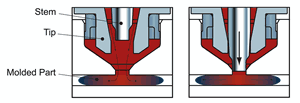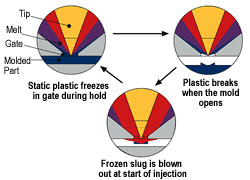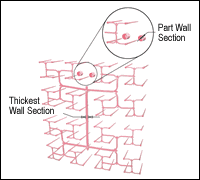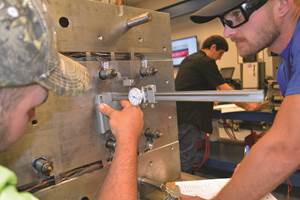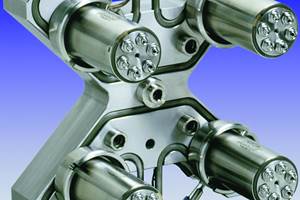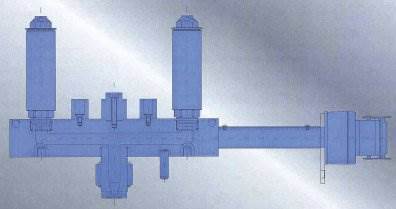Advancing Mold Performance Using Hot Runner Technology
A quality hot runner system is one of the more important enhancements you can incorporate into a mold to improve molded part quality, reduce production times and remain price competitive.
As global competition for molding plastic parts intensifies, there is tremendous pressure placed on reducing per piece molding costs. To remain competitive in this industry, you must produce a high quality product quickly, and at a competitive price.
One of the more important enhancements you can incorporate into your mold to improve molded part quality, reduce production times, and remain price competitive is to equip it with a quality hot runner system. A hot runner-equipped mold can:
- Lower cycle time and increase output;
- Significantly reduce production costs; and,
- Improve part quality.
Lower Cycle Time, Increase Output
The cycle time of any mold is largely influenced by the cooling cycle—how fast the resin can be sufficiently cooled so that the part can be ejected without permanent deformation. In any given mold, the areas that take longest to cool are those with the thickest wall section.
Since the runner must supply multiple cavities, it is common for the runner to have a thicker wall section than the molded part (see Figure 1). By eliminating the runner, the cooling time will be reduced by the difference in cooling time between the molded part and the cold runner.
Injection time is another component that differs between comparable hot and cold runner equipped molds. The injection time difference will be the extra time required to fill the cold runner.
Close and open stroke of the press is extended with cold runner equipped molds. The travel must be increased to accommodate safe ejection of the cold runner.
Parts molded with hot runners better lend themselves to automated part removal. With no runner to interfere with part removal, secondary mold processing times involving manual labor, including part/runner separation, part trimming and packaging, are reduced or eliminated entirely.
Collectively, these individual time reductions reduce the overall molding cycle, contributing to increased output per unit of time. Depending upon the production quotas, you may be able to free up the injection molding machine for another run often days, weeks, or even months earlier than anticipated. Figure 2 highlights the components of a typical molding sequence and where time savings when using a hot runner tool can be expected.
Significantly Reduce Production Costs
Although a more expensive capital investment upfront, a hot runner system is a significantly more cost-efficient means to keep production costs to a minimum over the long run.
Resin Savings
Since there is no cold runner to discard or recycle, resin consumption is reduced. Depending upon the molding application (i.e., medical components or parts requiring FDA approval), the product may require 100 percent virgin material—increasing overall consumption.
Energy Savings
Energy is wasted plasticizing, cooling and regrinding each cold runner that is produced. Increased energy consumption also is a direct result of extended cycle times.
Labor Savings
Secondary operations—such as manual part de-gating and trimming—are eliminated entirely with a hot runner system.
Mold Cost Savings
A smaller cavitation hot runner equipped mold may be able to satisfy production quotas using a smaller number of cavities since it runs at a faster cycle. The smaller mold frame size may enable installation into a smaller press.
Injection Press Costs
Hot runners allow reduced injection pressures during packing, as the system does not have to deal with injecting resin through a cooled runner. Melt in the cold runner may lose heat en route to the gate, possibly requiring higher heats and/or pressures from the injection molding machine. By reducing the injection pressure and clamp tonnage required, it is often possible to run the same part in a smaller tonnage machine as the clamp tonnage required is not as great.
Improved Part Quality
When selecting gate location (regardless of whether the tool features a cold or hot runner system), balanced and even filling of the molded part is the top priority. Cold runner gating provides the moldmaker with simplified integration in terms of selecting the optimal gate location, as the runner feeding the cavity can be more easily routed to avoid interference with mold features. Conversely, when selecting gate location with a hot runner system, the designer must consider maintaining a steel safe condition between the nozzle bore/gate detail and mold features. In certain situations, this may require additional work to modify the mold layout to satisfy the steel safe condition and maintain balanced/even filling. Advances in hot runner gating technologies and increasingly smaller hot runner nozzle diameters have expanded the list of gating options available to the designer, increasing the flexibility of gating options.
Although cold runners provide the designer with simpler integration upfront, the trade off is the improved gate quality that the hot runner offers. As the part is ejected in a cold runner mold, the runner must be trimmed from part. This can occur either manually or automatically via in-mold de-gating apparatus or via a three-plate mold. The resulting vestige is evident as a small bump (imperfection) on the molded part.
Hot runner systems provide molders with a variety of gating options that offer improved part quality relative to the cold runner alternative. Hot runner gating options fall into two main categories: thermal gating and valve gating.
Thermal Gating
This approach relies on the thermal properties of the tip and gate area to cause the resin to freeze (solidify) at the gate location (see Figure 3). When the melt within the cavity has cooled sufficiently, the part is ejected and the resin at the gate location is sheared—leaving a very small gate vestige on the molded part. As well, reduced injection pressures relative to a cold runner produces a more robust part since there is less risk of molded-in stress.
Valve Gating
A valve stem mechanically shuts off the melt flow by making direct contact with the gate steel (see Figure 4). The molded part separates from the gate without breaking or shearing the plastic; thus, discoloration or deformation due to gate break is unlikely. Physical properties of the molded part are improved with the use of a valve gate. Molded-in stress is a result of molecular orientation, which is caused by shear. Valve gates, due to the larger gate diameters, generate less shear compared to thermal gates. The result is a part with less warpage and better physical properties.
Long-Term Benefits
Despite the higher initial cost, the long-term benefits of equipping a mold with a hot runner system can be easily justified. A hot runner-equipped mold can effectively reduce molding costs without significantly increasing the complexity of the mold design. Generally, mold build leadtimes are not impacted as the hot runner is designed and manufactured in parallel with the mold.
It is in the best interests of the moldmaker to continually suggest ways for his/her customer (the molder) to reduce mold operational costs and increase mold output. By demonstrating these initiatives, the moldmaker confirms to the molder that the moldmaker is taking an active role in increasing the molder's overall profitability, which in turn increases the likelihood of repeat business for the moldmaker.
Related Content
How to Use Hot Runner Balance in Mold Qualification
If you are interested in the impact of system and hot runner balance on part quality, the causes of unbalanced hot runner systems and short shot parts, the procedure for measuring system balance and the impact of application specifics on system and hot runner balance expectations, then tune into this on-demand webinar.
Read MoreBreaking Down Hot Runner Maintenance
Improving a manifold’s maintenance plan requires specific skills and knowledge of its functioning areas.
Read MoreSix Key Factors for Evaluating a Hot Runner System
Details matter when it comes to selecting and integrating a hot runner system. This guide makes that process easier by covering those details thoroughly.
Read MoreRevisiting Some Hot Runner Fundamentals
What exactly does a hot runner do? If you’ve been in the injection molding industry for any length of time, you might think the answer is obvious, but it is not.
Read MoreRead Next
Unitized Hot Runner Systems Reduce Errors and Save Time
Unitized and integrated hot runner systems reduce machine downtime for increased production.
Read MoreAre You a Moldmaker Considering 3D Printing? Consider the 3D Printing Workshop at NPE2024
Presentations will cover 3D printing for mold tooling, material innovation, product development, bridge production and full-scale, high-volume additive manufacturing.
Read MoreHow to Use Strategic Planning Tools, Data to Manage the Human Side of Business
Q&A with Marion Wells, MMT EAB member and founder of Human Asset Management.
Read More



